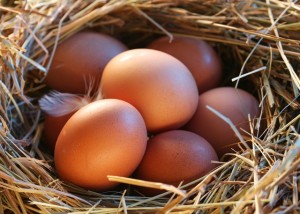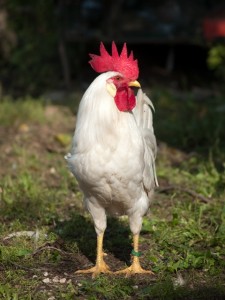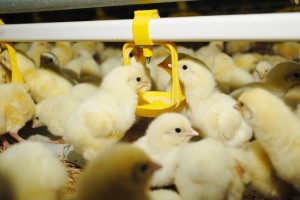Poultry Diseases
Aflatoxicosis in Poultry
Aflatoxins are the most commonly occuring and economically important mycotoxins, produced largely by a fungi called Aspergillus flavus. Aflatoxicosis is associated with grains and other feed sources such as corn, soyabeans, peanuts and millet. The fungal species Aspergillus parasiticus may also produce aflatoxins. Both fungi produce the toxic compound as they multiply under warm and humid conditions either in the growing crop or in storage. Although it is most commonly produced in warm climates, such as southern Europe, parts of United States and tropical areas, artificial environments also stimulate production of this toxin. There are four naturally occuring aflatoxins: B1, B2, G1 and G2. B1 is the most concentrated and toxic of these.
What Causes Aflatoxicosis?
The responses to the consumption of feed aflatoxins are diverse, depending on species, age, sex, nutritional status of the bird and levels of feed intake, and concentrations of the toxic compounds in the feed. The most susceptible poultry species are ducklings, followed by turkeys, goslings and chickens. Adult hens are the least sensitive (Arafa et al., 1981).
The liver is most affected and toxicity can result in severe liver necrosis (Bryden and Cumming, 1980). Mortalities tend to occur only at high levels of contamination (>10.0 ppm). In acute outbreaks, death tends to occur after short periods of reduced appetite. Sub-acute outbreaks are more common, and although sudden death can occur, anorexia and weakness are more typical symptoms. Depending on dose, aflatoxins might suppress spermatogenesis, cause abnormality in spermatozoa and atrophy in testes of male birds (Ortatatli et al., 2002).
Aflatoxicosis significantly reduces the efficiency of food conversion and dramatically decreases growth rates, egg production and egg hatchability and, in some cases, fertility of breeding males. Infection can also result in immuno-suppression (Eaker and Wadström, 1980), with birds becoming more susceptible to infections such as coccidiosis (Witlock et al., 1982), Marek’s disease, salmonellosis, candidiasis (Edds and Osuna, 1976)and fowl cholera (Hegazy et al., 1991). Lowered antibody levels against these and other key diseases, including Newcastle disease, have been observed in birds fed contaminated diets (Azzam and Gabal, 1998; Boulton et al., 1982; Gabal and Azzam, 1998). Aflatoxins have been shown to have the effect of making Gumboro disease (infectious bursal disease (IBD)) a much more severe disease and changing the symptoms (Chang and Hamilton, 1982).
There may also be abnormal pigmentation and increased bruising, resulting in economically important levels of carcass condemnation.
The effects of aflatoxins in feeds have been shown to diminish when soil is added to contaminated diets (Madden et al., 1999). Santurio et al (1999) proved that adding sodium bentonite neutralized the effects of aflatoxins in feeds (Santurio et al., 1999).
The severity of the response to aflatoxins and the ability of the birds to recover are dose related and dependant on the strain and sex of the chicken, with males being most susceptible (Bryden et al., 1980). Aflatoxin levels greater than 0.5 mg/kg in the diet have been shown to decrease food intake and food conversion and retard growth. Sharlin et al., (1981) also demonstrated reduced feed consumption and decreased reproductive potential in mature White Leghorn males fed aflatoxins (Sharlin et al., 1981).
Exarchos and Gentry (1982) examined the impact of various levels of aflatoxins on egg production and showed that at high levels (5 mg/kg), egg production ceased after 3 days, restarted at 22 days and was normal after 10 weeks (Exarchos and Gentry, 1982). At 1 mg/kg production was greatly reduced for 3 weeks, ceased during weeks 4 and 5, and returned to normal after 8 weeks. At 0.7 mg/kg production fell to 14% and 17% during weeks 5 and 6 and gradually returned to normal over the next 4 weeks. Lower doses (0.4 and 0.1 mg/kg) had only a moderate or small effect on egg production (Exarchos and Gentry, 1982).
Jones, Hagler and Hamilton (1982) showed an association between low levels of aflatoxin in feed and productivity losses in commercial broiler operations. Their work suggested that aflatoxins may be produced during and after feed manufacture in apparently normal operations, and that low levels of aflatoxin are associated with productivity losses in apparently healthy broilers (Jones et al., 1982).
Further reading: Cornell University have produced a comprehensive guide to Aflatoxins. To access it click here.
Control and Prevention of Aflatoxicosis in Poultry
Good hygiene and the regular cleaning of storage bins, silos and feeding equipment are extremely important. Control is best achieved by the avoidance of contaminated feeds.
There are statutory regulations on permitted levels of aflatoxins in feed for livestock in the US and the EU, so those purchasing compound feed from reputable sources should not have an issue with incoming feed. However, good storage will still be important.
Aflatoxin formation has been shown to be associated with high relative humidity in houses and with storage of the feed in the house for long periods (Jones et al., 1982). Since relative humidity and storage time in houses can be altered, aflatoxin formation might be limited by controlling these two factors.
Aflatoxicosis and Diet Supplementation
Incorporation of sodium bentonite in broiler diets has been shown to reduce the incidence and severity of the hepatic histopathology changes associated with aflatoxicosis (Miazzo et al., 2005; Rosa et al., 2001). There are reports of a yeast component (esterified glucomannan) being shown to diminish the adverse effects of aflatoxins in broiler chicks(Basmacioglu et al., 2005).
The protective role of the polyherbal feed supplement called Growell has been demonstrated. The observed impaired immune response and histopathological changes in liver, kidney, spleen, bursa of Fabricius and thymus of broilers given mycotoxins were protected by supplementation of Growell (Kalorey et al.). The addition of yeast component, mannanoligosaccharide (MOS) to the diet of quails significantly reduced the adverse effects of aflatoxins on feed consumption, body weight gain and feed conversion ratio (Oguz and Parlat, 2004). The supplementation of 0.5% Saccharomyces crervisiae partially ameliorated the adverse effects of aflatoxins in broilers in respect of weight gain, feed efficiency, total serum protein and prothrombin time (Modirsanei et al., 2004). NovaSil PLUS (NSP), a calcium montmorillonite clay that is commonly used as an anticaking agent in feeds, significantly protected broiler chicks from the effects of high-level exposure to aflatoxins (Pimpukdee et al., 2004).
Oluwafemi and Taiwo (2004) showed that aflatoxin from Aspergilus flavus in cockerels could be successfully reversed by the concurrent administration of alcoholic extract of M myristica, a tree widely distributed along the west coast and central Africa. Supplementation of selenium had some protective action against the toxic effect of aflatoxin B-1 in Japanese quail (Jakhar and Sadana, 2004).
Treating Aflatoxicosis in Poultry
No specific treatment for aflatoxicosis is known. Since aflatoxins do not accumulate and persist in body tissue, birds do recover from moderate intoxication after the contaminated feed has been removed.
Good Practice Based on Current Knowledge
- Do not store food in damp conditions
- Buy smaller quantities during winter
- Ensure litter is not mouldy
- For mobile systems, move housing onto fresh ground with clean dry litter


 British English
British English




Comments are closed.